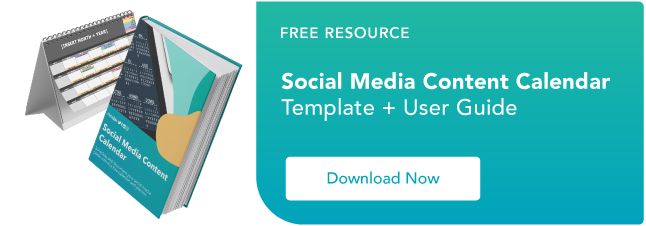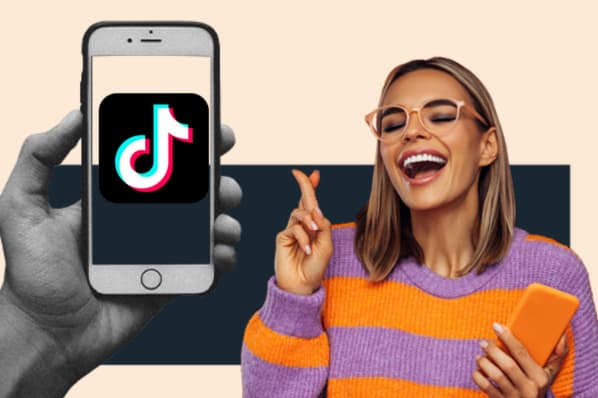It's no mystery that social media is a crucial part of any marketing strategy -- regardless of industry, company size, product, or service.

We've all been there. Back in the day, I had to make the case for some businesses to even have a social media presence in the first place. But finally -- finally! -- it seems like folks are catching on. After all, 69% of marketers are using social media to build a following.
Now that most marketers really do understand that social media is a strategic must-have, how can we make it more manageable? Like many other things in life and in business, planning ahead is the way to go.
To avoid becoming one of those brands whose Facebook page hasn't been updated in months -- and we've all seen them -- learning to plan and schedule your social media posts in advance is key. But how? We've outlined nine crucial questions to ask when you start this planning process, along with some helpful tools and resources to help along the way.
9 Questions About Planning and Scheduling Social Media
1) What are you promoting?
Part of planning your social media presence is knowing what you’re there to talk about. Maybe you have a looming product launch to promote, a holiday special, or a particular piece of content to get in front of the public eye.
In any case, knowing what you’re promoting should run in tandem with your social media schedule. Do you have multiple product or content launches taking place over the course of the year? That’s where a calendar is particularly useful -- not only to announce the launches themselves, but to drop “teasers” leading up to them.
That’s also a good place to plan other pieces of your online presence, like your blog, around these launches -- especially considering that 84% of marketers integrate social media with their overall marketing plans.
Let’s say you’re launching an annual report, and you want to use social media to push a high number of downloads. In the days leading up to it, your blog can feature smaller pieces of content pertaining to the different findings within that report. That creates a top-of-mind presence of your brand and your content, among your audience -- just in time for the big launch.
2) What are your goals?
In 2015, Google did a study of Digital Leaders -- the folks who have seen success with digital marketing -- versus Digital Learners -- those who have not. Out of the two, a whopping 92% of Leaders had clear digital marketing goals, compared to only 69% of Learners.
Those numbers illustrate the importance of outlining goals when planning social media posts and campaigns. That doesn’t mean they have to be dry or boring -- it just means that even funny or out-of-the box posts still need to be aligned with what you’re trying to accomplish.
Just have a look at this collection of Twitter success stories, and the subhead introducing them: "Learn how businesses from around the world achieved their goals with Twitter."
In the Greenhouse software case study, for example, there’s a very clear objective stated: “The marketing team at Greenhouse was focused on acquiring new subscribers for their weekly newsletter," which was "focused on increasing brand awareness and purchase consideration."
Notice how there are three pieces to the Greenhouse goal:
Increase awareness → newsletter subscription → purchase consideration
In addition to overall greater brand awareness, Greenhouse experienced 15% increase in newsletter subscribers within one short month. But remember -- it was a two-pronged approach. In order to drive purchases, Greenhouse knew that its digital marketing would first have to aim for brand awareness, which would drive newsletter subscriptions.
Think about your ultimate goal -- be it sales, downloads, or event attendance -- and consider the smaller pieces that will lead to it. Then, shape and schedule your social media presence around those variables.
3) Who is your target audience?
Here at HubSpot, we’re big on buyer personas -- the semi-fictional “characters” that encompass the qualities of who you’re trying to reach.
Outlining your personas is a vital part of planning your social media presence. It’s one of the best ways to determine the needs, goals, and behavior of your potential customers, which can dictate how you digitally convey a product or service. In turn, that can help you understand the voice to use when trying to reach that audience. It works -- 82% of companies with better value propositions also use buyer personas.
When you plan and schedule your social media, think about your personas. What are they looking for? What motivates them? What’s going to help them? How are they going to feel at a given time of year? Answering those questions can help determine what kind of media your personas are consuming. To get started, check out HubSpot’s MakeMyPersona tool.
4) What can your audience do with what you’re promoting?
Earlier, when asking about your personas, I posed the question: “What’s going to help them?”
That’s part of the reason why it’s so important to know who your personas are -- to make sure that they can actually do something with the content you’re posting on social media. When you plan or schedule a social media post, ask yourself if it’s going to interest, benefit, or ultimately delight your target audience. If the answer is “no,” reconsider sharing it.
Also consider what’s wrong with it. Is there something specific that’s making your social media posts less sharable or engaging? Even the network you’re using can have an impact, since different types of content have varying results, depending on the platform.
Which brings us to our next question ...
5) Are you planning accordingly for each network?
Not all social media is created equal. Different platforms attract different audiences. Plus, each one has its own “secret sauce” of when to post, and how often -- check out the best times to post to each network.
Remember your buyer personas? As you figure out who they are, it’s also important to determine where they “live” online, and what kind of media they’re consuming -- that will help you plan your social media presence for each individual network. It might be helpful to review the Pew Research Center’s Demographics of Social Media Users, which profiles the users of five major social media platforms -- Facebook, Pinterest, Instagram, LinkedIn, and Twitter.
While you’re at it, have a look at HubSpot’s Social Media Content Calendar. With a tab for each social network, it’s easy to plan posts by month, week, or even day. That’s an asset when it comes to the networks that require multiple posts per day, and can aid in planning for seasonality.
And speaking of seasonality ...
6) Are you promoting seasonal content?
I don’t know about you, but I love the holidays. But I also like them with the right timing -- in other words, I don't get excited when I hear carols and bells in October. Too soon, right?
That said, it’s still a good idea to start planning your social media holiday presence early on. And, it’s important to understand how your personas behave during certain times of the year -- there’s a big difference, for example, between B2B and B2C audience behavior during the holidays.
For B2C, it’s a bit more clear-cut. Brands see more first-time buyers during the holidays than they do during the rest of the year, when shoppers are “more influenced by brand allegiance,” writes SocialTimes ’ Kimberlee Morrison.
For that reason, it’s important to use a calendar to schedule posts that will both engage potential first-time buyers, and keep them coming back after the holidays. That’s called reactivation -- and according to Monetate, it's imperative if you don't want to your first-time customers to be part of the 86% of them who never come back.
In the B2B sector, it’s less about influencing purchases and more about increasing brand awareness. Around the holidays, for example, B2B companies are encouraged to promote sharable content that’s both seasonally-oriented and branded. That’s especially true on Facebook, which people browse 4.2X as much as they do search engines before shopping. So while you might not be offering a holiday promotion, you’re still aligning with the mood of your buyers -- and keeping your brand at the top of their minds.
7) Are your posts agile enough to be replaced or rescheduled on short notice?
Despite our best planning efforts, unexpected things still come up. The world keeps turning, despite what our social media schedule dictates -- which is why it’s important to keep it flexible.
When you plan your social media presence, it’s generally a best practice to leave open slots for things like breaking news or the content that you develop around unexpected current events.
My colleague, Susannah Morris, uses HubSpot’s Social Inbox app to flexibly plan social media this way. “I schedule out evergreen content and curate it as I go,” she says, “leaving slots to fill in with new content, newsjacking, or other interesting things closer to the time.”
In other words -- things come up, so be sure to allow for them as you plan your posts ahead of time. But make sure you have a back-up plan, too, and a backlog of timely, sharable content to use as an alternative.
8) What’s performed well on your social networks in the past?
There’s a reason why 72% of marketers analyze their social media activity -- they want to see what's working.
But conversely, only 42% of marketers believe they can do such an analysis. Measuring the ROI of social media is known for being a bit tricky. Which network performs best? What kind of posts? What time of day? It’s answering all of the questions we’ve posed so far, and finding out if your answers to them are effective. And that data on what's working -- as well as what isn't -- will ultimately influence your future social media posts.
Digging into that data doesn’t have to be so complex, and there are quite a few resources that can help. Some social media platforms, like Facebook and Twitter, have their own analytic tools that provide some insights into post performance. And in your HubSpot software, you can use the Sources report to measure the ROI of your marketing campaigns, including details on how social media is driving traffic to your site -- those are things like visits from links clicked on Facebook, Twitter, LinkedIn, and more.
But in the case that you also have to illustrate the effectiveness of your social media -- especially when using that data to plan and schedule future posts -- it can be helpful to compile a monthly report that can shed detailed light on performance. Not sure what kind of data to include? Check out our ebook on how to present and prove your social media ROI -- it comes with some templates to help you get started.
9) Have you identified influencers?
When it comes to genuinely reaching your audience, trust is huge. That’s why so many of us seek the advice of friends and family in choosing a product or service -- 83% of people trust their recommendations more than anyone else’s.
But then, there are influencers -- people considered to be leaders and trendsetters in their respective niches (think: bloggers). Many times, brands partner with influencers because the public listens to what they have to say. In fact, 49% of Twitter users say they count on recommendations from influencers first.
There’s a reason why it’s called social media. We've come to think of contacts on these networks as reliable acquaintances, even if we’ve never met them in real life. That’s why people like influencers have earned a so much consumer trust, and why marketers are partnering with them.
In fact, many businesses say that they earn $6.50 for every $1 they invest in partnerships with influencers. That’s because influencer campaigns are a bit like economical celebrity endorsements -- people have come to recognize, follow, and trust what they have to say.
But many marketers say that finding the right influencers to work with can be challenge. For that, we recommend following a process similar to identifying your buyer personas, to make sure the influencers are aligned with what your brand represents, as well as your goals. And be sure that it’s a mutually beneficial partnership -- much like a co-branding agreement, it’s important to determine what you can offer an influencer in return.
Ready to start planning?
With the right tools, managing social media isn’t so overwhelming. And planning ahead can help to create that peace of mind, especially when you allow for the flexibility we discussed earlier.
But make sure you’re not overdoing it. The amount of time spent on social media can vary from marketer to marketer, and can even depend on your industry. Answering these questions and following the right steps accordingly will help determine what works for you.
And as social media continues to evolve, we’ll be here to let you know about it, and what it means for you.
How do you plan and schedule social media? Let us know in the comments.




![8 Shifts Social Media Marketers Should Make in 2023 [Insights from 1,000+ Professionals]](https://www.hubspot.com/hubfs/social%20media%20recommendations%20for%202023.jpg)





